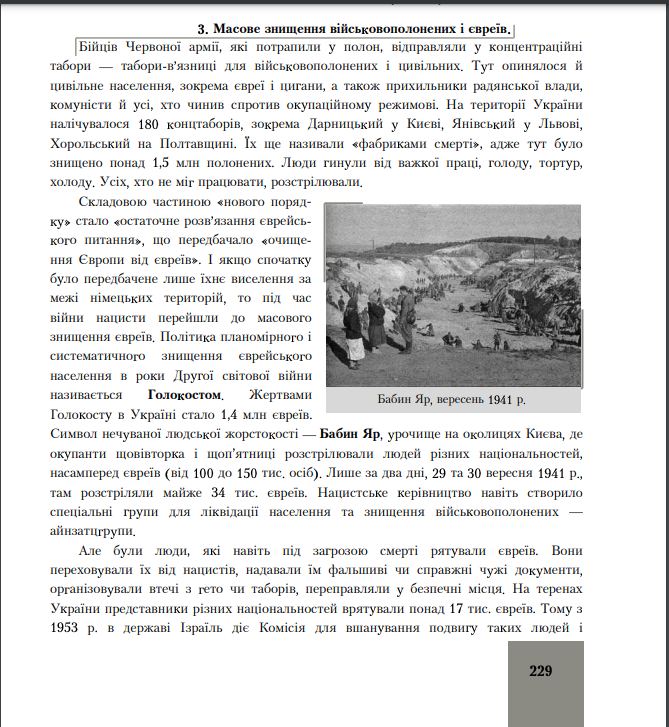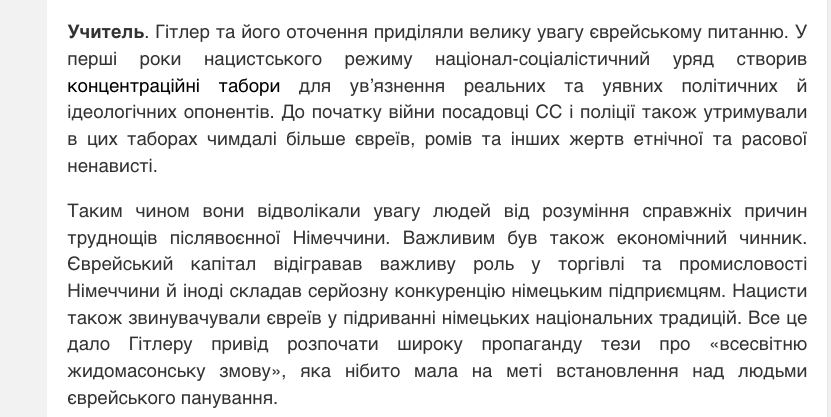The Devil is in the Details: How Ukrainian History Textbooks Depict the Extermination of Romanis by
The Devil is in the Details. School curricula, syllabi, textbooks, methodological materials only serve as a corroboration thereof. How are we even going to implement global and consequent changes if we encounter the following in the course of our lessons…
There are only minor mentions of the tragedy of the Romani nation during the Second World War. We find extensive descriptions of the extermination of Jews but other ethnic groups that have suffered only merit a couple of lines, in the ‘and others’ category.
We have analysed the corpus of popular history textbooks. One can find these on the website of the Institute for Modernisation of the Content of Education. That is a state institution within the Ministry of Education of Ukraine. So these books are available at any Ukrainian school. What are these books then? Let us take a look.
«The History of Ukraine (major level)», a textbook for 10th year students of general education school, by V. S. Vlasov and S. V. Kulchytskyi.This is how this textbook describes the Holocaust: «The Nazi Neue Ordnung stipulated for a special race policy, victims to which were Jews, Romanis (Gypsies), and Slavic Ethnicities. There were hundreds of camps and ghettos set up in Ukraine to isolate and ultimately exterminate the Jewish and other ethnic groups».

Now here is the questions. Is this gypsy clarification really necessary? And why is it being used without the explanation of the negative context of its usage? It looks like it is supposed to mean the following: «These words are synonyms». No, they are not.
And what about «other ethnic groups»? Shouldn’t one be more specific? Let us remind ourselves this: a textbook covers a specific area of knowledge. So let us not be worried for schoolboys and schoolgirls, for fear they get overloaded by «redundant» information.
The same textbook features the following description of the Holocaust: «…this is a term describing the genocide of Jews by the Nazis during the Second World War…» Here, «other ethnic groups» are not even mentioned.

The abovementioned authors have developed this textbook for the basic level, too. And it features no modification: the history of the Holocaust is described in a straightforward manner. That is, it contains a gypsy specification and ignores other groups affected by the terror.
A similar situation is encountered in a textbook entitled History of Ukraine (standard level), a textbook for the 10th year students of general education schools, authored by I. O. Burneiko, H. M. Khlibovska, M. Ye. Kryzhanovska, and O. V. Naumchuk . It contains a topic-dedicated paragraph entitled Mass Extermination of POWs and Jews. The text of the paragraph contains the words people of various ethnicities.
.jpeg)
Of course, the death toll of Jews was the largest one. But stressing upon a single group of victim distorts the perception of the scope of Nazi crimes.
«Babyn Yar became the symbol of Holocaust in Ukraine. <...> every Tuesday and every Friday, people of various ethnicities—mostly Jews—were gunned down » – so says the History of Ukraine (standard level), a textbook for 10th year students of general education schools, authored by O. R. Hisem and O. O. Martyniuk.»

There is another approach, case in point: a textbook developed by O. K. Strukevych. It should be noted that this is a textbook for the standard level, not for the specialised level. The topic-related paragraph mentions Jews, Romanis (just Romanis, with no topical specifications nor comments), people with mental aberrations, hospital patients, POWs.

Not so difficult, is it? Just mention everyone, that’s it. In my opinion, this is also an expression of respect towards anyone exterminated by the Nazi regime. The least one can do is mention, name, and remember.
Of course, any changes and new editions of textbooks is a complex and costly undertaking. However, teachers can in fact organise lessons in a manner considering all the nuances. Or can they not?
Turns out they in fact cannot. One of the popular education portals where teachers share their designs of lessons, we encounter a brief phrase: «the place where POWs and Gypsies were gunned down». Does the teacher realise that by using this vocabulary, he amplifies the stigma? And how, in the context of ethnic hatred, can one use words that are markers of this enmity?

On the same online platform, however, in a different methodological material, we encounter a more acceptable description: «…in addition to this, they were holding increasingly more Jews, Romanis, and other victims of ethnic and racial hatred».
It should be noted that both designs were elaborated the same year. That is, both teachers came from the same historical and social context. So why such polar approaches to teaching?
Why is this important? Because even a single word impacts one’s conscience. A single word shapes one’s attitude. The community itself has determined an acceptable endonym: Roma/Romani. So why do people of another ethnic group (teachers, book authors) allow themselves to neglect that?
And how can one teach tolerance to children if the children see the disrespectful term Gypsy in their textbooks? After that, let us agree that this term is never used in a positive context.
The Devil is in the Details. And every word matters.
See also
- «Невидимі. Стійкість: минуле і сучасність ромів». Як зрозуміти історію ромів через візуальну культу
- Альфреда Марковська: історія життя і порятунку інших
- «Дивись і не забувай»: 15 років Dikh He Na Bister у Кракові
- ФОТОРЕПОРТАЖ: У Києві відкрили виставку про ромську історію та ідентичність
- «Відновлення пам'яті – роми у Варшавському гетто». Історична екскурсія у Варшаві
- PHOTO REPORT: Events commemorating the victims of the Roma genocide in Babyn Yar
- 2 серпня — Міжнародний день памʼяті жертв геноциду ромів
- Коли допомога — це більше, ніж ваучер
- Антициганізм поруч: як розпізнати упередження у звичних словах і жартах
- Стереотип замість культури: як TikTok спрощує ромську ідентичність